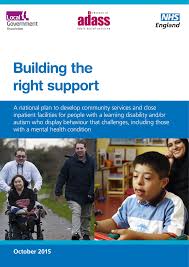Transforming Care
The sorry failure of an ambitious plan
Transforming Care pledged to replace half of inpatient places with support in the community. Despite confident projections, numbers are little changed and scandals about assessment and treatment units continue. How did good intentions go wrong? asks Simon Jarrett

 Reinventing the asylum? Matthew Garnett’s detention and treatment in St Andrew’s Hospital (in the former Northampton Pauper Lunatic Asylum) was raised in a Channel 4 Dispatches documentary in 2017
Reinventing the asylum? Matthew Garnett’s detention and treatment in St Andrew’s Hospital (in the former Northampton Pauper Lunatic Asylum) was raised in a Channel 4 Dispatches documentary in 2017
Transforming Care came to an end in March 2019. It ended quietly, in contrast to the fanfare when its national plan in late 2015 promised to close hundreds of hospital beds for people with learning disabilities by improving community services.
The plan – Building the Right Support (NHS England, 2015) – predicted that up to half of national inpatient provision would have closed by 2019, with alternative care provided in the community. In three years, the document predicted confidently, we would expect to need hospital care for as few as 1,300 people instead of the current 2,600. Savings from this transformation would be reinvested into community services, following upfront investment.
The reality has been very different. As Community Living was going to press, the latest data available from the programme, for the end of January 2019, showed that 2,305 inpatients with learning disabilities and/or autism were in hospital. The majority – 1,325 (58%) – had been in hospital for more than two years. Almost half had gone six months without a review (NHS Digital, 2019a).
During January, 150 people were discharged but, of these, only 100 moved back into the community rather than into other so-called ‘specialist’ settings. In the same month, 100 new admissions took place. In other words, the numbers hardly shifted, even as the Transforming Care programme approached its close, when an acceleration might have been expected (NHS Digital, 2019a).
According to these figures, the number of people needing hospital care has fallen by just under 12% from 2,600 in late 2015 to 2,305 in early 2019. Not all of those 12% have returned to their communities by any means.
The forecast reductions of 50% seem to have been at best a triumph of optimism or at worst a fantasy.
If we look at the wider picture, things appear even more grim.
As well as providing data on Transforming Care itself, NHS England produces something called the Mental Health Services Data Set. This shows the numbers of people with a learning disability and/or autism in ‘NHS funded secondary mental health, learning disability and autism services in England’. This has a wider scope than the Transforming Care statistics and includes, for example, care commissioned in England but provided elsewhere in the UK.
The latest available statistics, from November 2018, show 3,670 people with learning disabilities and/or autistic spectrum disorders were in hospital, of whom 1,355 have been in hospital for more than two years (NHS Digital, 2019b).
The barrage of statistics can appear daunting, but the message from them is clear Ð little, if anything, has changed, let alone transformed.
Sadly, the 3,000 Lives Campaign, which called to move the 3,000 people with learning disabilities out of institutional care and has been championed by this magazine for a number of years, has no need to change its name to the 1,000 or even the 2,000 Lives Campaign.
Growing institutionalisation
Indeed, a shocking series of press and television exposees have suggested that the problems of institutionalisation in health settings have become even worse.
Last October, The Times (Ford, 2018a) reported that ‘hundreds of people with autism are being locked up in poor conditions, abused and left in small, secluded padded cells’.
Liberal Democrat MP Norman Lamb intervened in the case of a 15-year-old girl in an assessment and treatment unit (ATU) who was regularly restrained. Lamb said that ‘she behaved like an animal because she was treated like one, but from the moment she left, she never needed to be restrained again’ (Ford, 2018a).
The following month, the same newspaper reported on the case of 17-year-old Bethany, a patient at St Andrew’s Hospital in Northamptonshire, who was secluded for months in a bare room, with food passed to her through a hatch. The cost of her ‘care’ was more than £13,000 per week. (Hurst and Greenwood, 2018).
A further Times report in December noted that the number of people with autism detained in psychiatric hospitals had actually risen from 1,100 in 2015, when the pledge to reduce the number by half was made, to 1,180 in 2018 (Hurst, 2018).
The parliamentary Joint Select Committee on Human Rights were so alarmed by what they discovered about poor treatment in ATUs that they wrote to the secretary of state for health and social care demanding action. They reported that between 2016 and 2017 the number of recorded restraints increased by 50%, and the number of recorded isolations by 40% (Joint Select Committee on Human Rights, 2018).
Journalist Ian Birrell has written numerous articles highlighting the injustices and abuses of the system of detention of people with learning disabilities. He says these incidents are not isolated but arise from systemic failure.
It is shocking to read his words, in a Daily Mail article in December 2018: ‘I have interviewed abused women, bereaved parents, torture victims and girls in the captivity of jihadis. I have seen fields strewn with dead bodies, hospitals flooded with ebola victims and towns crushed by aerial bombing. But nothing has felt so traumatic as my investigation for this newspaper of people with autism and learning disabilities being locked up in cruel and destructive conditions across Britain’ (Birrell, 2018a).
All this shows a deeply disturbing catalogue of abuse, human rights violations and callous disregard for the humanity of people with learning disabilities.
Against this background and data, Transforming Care cannot lay claim to any success.
So why has Transforming Care failed to transform, and why are we instead faced, alarmingly, with a deteriorating rather than an improving situation?
Intention versus reality
The original aim of the programme was laudably simple: ‘Transforming care is all about improving health and care services so that more people can live in the community, with the right support, and close to home.’
The plans were clear: £100 million would be invested in new community housing to facilitate hospital discharge. Three new models of local service would be introduced across the country – ‘enhanced intensive support’ in people’s own homes, community-based forensic support to divert people from the criminal justice system and secure hospitals, and a network of local acute admission services focused on rapid assessment, rehabilitation and reintegration.
As a result of these initiatives, hospital numbers would drop and the money saved would be transferred to rebuild community services. This would create a virtuous circle of ever-improving community services leading to ever-reducing demand for inpatient detention.
No one is denying the good intentions of the plan or those who worked on it. However, despite its commitment to working with stakeholders, it has always felt like an old-fashioned, top-down, command-and-control NHS initiative. Monthly micromanagement of commissioners, relentless demands for data and the imposition of a one size fits all service model have led to a concentration on process and a defensive mindset among commissioners, where creativity and local improvisation around complex problems have been stifled.
 The national plan: despite intentions to provide community care, service users have been moved into high-cost specialist units, often far from home and with no better values than inpatient care
The national plan: despite intentions to provide community care, service users have been moved into high-cost specialist units, often far from home and with no better values than inpatient care
At times, the whole initiative has been counterproductive. Commissioners have placed people into extremely expensive ‘specialist’ provision in the private and voluntary sectors, often far from their homes, and often with no better values than the inpatient facilities from which they have been moved. Technically, this counts as success in moving people off the Transforming Care books, despite achieving no improvement in a person’s situation.
In addition, this can drain funds from the system rather than release cash for community services. While it is easy to blame all difficulties on austerity – which has dramatically cut the kind of preventive community services that Transforming Care requires – support for people with learning disabilities suffers not so much from a lack of resources as from a grotesque misallocation of them.
Whiff of corruption
As Birrell has eloquently put it, and as we have argued tirelessly in this magazine, ‘there is a whiff of corruption emerging from this system as rapacious private firms muscle in on the system, raking off vast profits while having the power to determine if people can escape their clutches. Multinationals, hedge funds and private equity groups are buying up psychiatric units holding these people and opening new centres’ (Birrell, 2018b). It should, however, also be noted that St Andrew’s Healthcare – which has often found itself at the heart of many of these concerns – is a registered charity.
A dangerous vacuum of provision has been created by a combination of weakly implemented policy, inattention from the government (and the opposition) and fragmentation and disarray across social care. Into this space have stepped powerful companies working to a medical model, backed up by psychiatrists reasserting the old claim that medical authority alone should determine how people with learning disabilities are treated.
Against such interests, the Transforming Care programme has been flattened like a hedgehog trying to cross a motorway.
” Support suffers not so much from a lack of resources as from a grotesque misallocation
of them”
It was perhaps always too much to ask the NHS to understand that the medical model is not right for people with learning disabilities. Wonderful as is the work of the NHS in other areas, it has never had an easy relationship with learning disability.
The successful deinstitutionalisation of the 1980s and 1990s was led by a genuine alliance committed to the social model. We need to do this again to defeat this new set of monstrous institutional injustices.
The Transforming Care programme will be rolled out in some new form or other, but no one should hold their breath if they want to see transformation. It’s time to take the fight against arrogant medical authority and rapacious profit-seeking companies into another arena.
Simon Jarrett is the editor of Community Living
If you don’t subscribe but appreciate our open articles we’d always appreciate a small donation which you can make for no charge at Paypal Giving using a debit or credit card. DONATION
No donation too small – it all helps our charity to keep speaking out.
References
Birrell I (2018a) I have seen so many horrors, but this is barbarism. Daily Mail; 22 December. http://tinyurl.com/y5ap3ako
Birrell I (2018b) Young people are being locked away for years because they have autism and learning disabilities. Some never make it out. iNews. http://tinyurl.com/y575qt8h
Ford R (2018a) Autistic teenagers ‘locked in padded cells and abused’. The Times; 29 October
Hurst G (2018) Psychiatric units holding more autistic people. The Times; 6 December
Hurst G, Greenwood G (2018) Taxpayer-funded psychiatric care offers healthy return for investors. The Times; 5 November
Joint Select Committee on Human Rights (2018) Learning Disabilities And Autism: Stronger Human Rights Protection In Atus? 5 December. http://tinyurl.com/y5bnyzdq
NHS Digital. Learning Disability Services Monthly Statistics – Provisional Statistics (AT: January 2019, MHSDS: November 2018 Final). 2019a; 21 February. http://tinyurl.com/y36uqbot
NHS Digital (2019b) Mental Health Services Monthly Statistics – Final November, Provisional December 2018. http://tinyurl.com/y25pepvr
NHS England (2015) Building the Right Support. www.england.nhs.uk/learning-disabilities/care/
